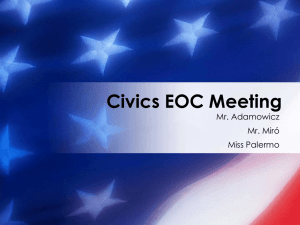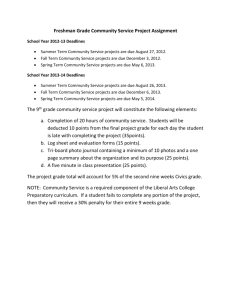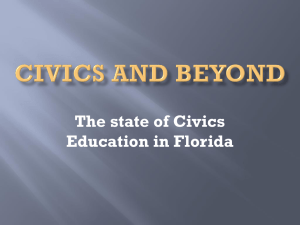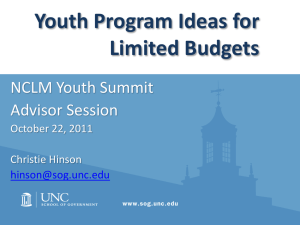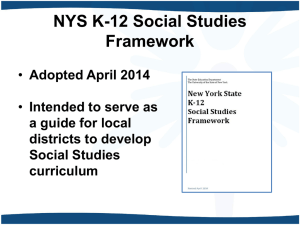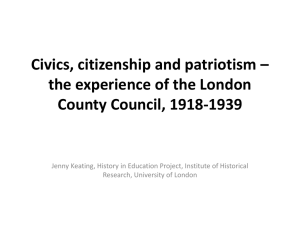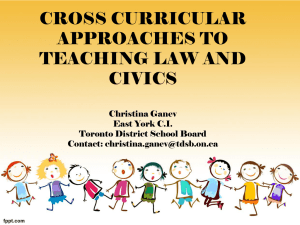Grade 9 Civics Syllabus - Delaware Department of Education
advertisement
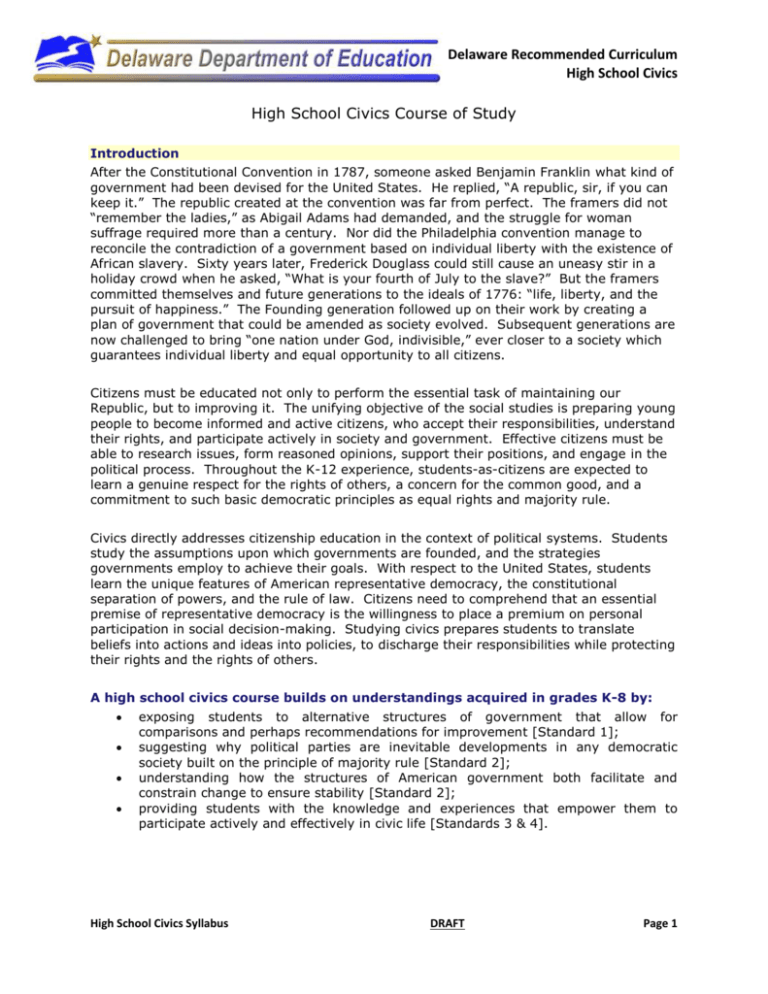
Delaware Recommended Curriculum High School Civics High School Civics Course of Study Introduction After the Constitutional Convention in 1787, someone asked Benjamin Franklin what kind of government had been devised for the United States. He replied, “A republic, sir, if you can keep it.” The republic created at the convention was far from perfect. The framers did not “remember the ladies,” as Abigail Adams had demanded, and the struggle for woman suffrage required more than a century. Nor did the Philadelphia convention manage to reconcile the contradiction of a government based on individual liberty with the existence of African slavery. Sixty years later, Frederick Douglass could still cause an uneasy stir in a holiday crowd when he asked, “What is your fourth of July to the slave?” But the framers committed themselves and future generations to the ideals of 1776: “life, liberty, and the pursuit of happiness.” The Founding generation followed up on their work by creating a plan of government that could be amended as society evolved. Subsequent generations are now challenged to bring “one nation under God, indivisible,” ever closer to a society which guarantees individual liberty and equal opportunity to all citizens. Citizens must be educated not only to perform the essential task of maintaining our Republic, but to improving it. The unifying objective of the social studies is preparing young people to become informed and active citizens, who accept their responsibilities, understand their rights, and participate actively in society and government. Effective citizens must be able to research issues, form reasoned opinions, support their positions, and engage in the political process. Throughout the K-12 experience, students-as-citizens are expected to learn a genuine respect for the rights of others, a concern for the common good, and a commitment to such basic democratic principles as equal rights and majority rule. Civics directly addresses citizenship education in the context of political systems. Students study the assumptions upon which governments are founded, and the strategies governments employ to achieve their goals. With respect to the United States, students learn the unique features of American representative democracy, the constitutional separation of powers, and the rule of law. Citizens need to comprehend that an essential premise of representative democracy is the willingness to place a premium on personal participation in social decision-making. Studying civics prepares students to translate beliefs into actions and ideas into policies, to discharge their responsibilities while protecting their rights and the rights of others. A high school civics course builds on understandings acquired in grades K-8 by: exposing students to alternative structures of government that allow for comparisons and perhaps recommendations for improvement [Standard 1]; suggesting why political parties are inevitable developments in any democratic society built on the principle of majority rule [Standard 2]; understanding how the structures of American government both facilitate and constrain change to ensure stability [Standard 2]; providing students with the knowledge and experiences that empower them to participate actively and effectively in civic life [Standards 3 & 4]. High School Civics Syllabus DRAFT Page 1 Delaware Recommended Curriculum High School Civics Civics Benchmarks for Grades 9-12 Government Civics Standard One 9-12a: Students will analyze the ways in which the structure and purposes of different governments around the world reflect differing ideologies, cultures, values, and histories. Politics Civics Standard Two 9-12a: Students will examine and analyze the extra-Constitutional role that political parties play in American politics. Civics Standard Two 9-12b: Students will understand that the functioning of the government is a dynamic process which combines the formal balances of power incorporated in the Constitution with traditions, precedents, and interpretations which have evolved over the past 200 years. Citizenship Civics Standard Three 9-12a: Students will understand that citizens are individually responsible for keeping themselves informed about public policy issues on the local, state, and federal levels; participating in the civic process; and upholding the laws of the land. Participation Civics Standard Four 9-12a: Students will develop and employ the skills necessary to work with government programs and agencies. Civics Standard Four 9-12b: Students will understand the process of working within a political party, a commission engaged in examining public policy, or a citizen’s group. High School Civics Syllabus DRAFT Page 2 Delaware Recommended Curriculum High School Civics Week 1 Introduction Purposes of Civics Education Every academic course should begin and end with an examination of purposes. Why, a student might ask, do I have to learn this? Answers provide motivation for learning. Students who do not consider and buy into why they are asked to learn a subject are more likely to be disengaged. The first week of this course is devoted to helping students understand why they are asked to learn civics (purposes, goals, objectives), providing an overview of the course of studies, and introducing students to the culminating project for the course, Project Citizen. Possible reasons for studying civics that teachers will want to explore with students include: promoting civic competence; helping our youngest citizens find ways to participate in the political and social life of their communities and nation; encouraging patriotism and national pride; teaching citizens in a democracy how to govern themselves, promoting civic responsibility; helping self-governing citizens understand their responsibilities; building national cohesion; assimilating immigrants; encouraging citizens to seek ways to improve civic life. Project Citizen Overview & Recommendations Project Citizen is a culminating project that requires attention throughout the course. Introduce students to the project very early in the semester by teaching the Project Citizen unit up to the point where groups of students select a community problem to address and begin their research. Set aside structured time at different points in the semester (e.g. every Friday) to give students time to develop their research and create their portfolios, exhibits and presentations. Plan to spend approximately 4 weeks (individual or chunks of days) spread over the semester on Project Citizen. Recommended Project Citizen Semester Outline Weeks 1 and 2: Lesson 1 through Lesson 3, Strategy 1 Weeks 3 through 14: Lesson 3, Strategies 2 through 4 Student independent research, class computer lab time, and weekly debriefing Weeks 15 and 16: Lesson 3, Strategy 5 Project Showcase High School Civics Syllabus DRAFT Page 3 Delaware Recommended Curriculum High School Civics Weeks 2-3 Comparing Structures of Government Understanding how and why governments are structured as they are equips citizens with the ability to navigate their government as they strive to contribute to the public good and seek solutions to public policy problems. Studying structures of government also provides opportunities to evaluate advantages and disadvantages of existing structures with an eye toward improvements. Differences in the histories (e.g., colonial experience), cultures (e.g., ethnic or religious diversity), prevailing ideologies (e.g., classical liberalism, republicanism), and values (e.g., individual rights, justice, equality of opportunity) of different countries help explain differences in the structures of government around the world. In earlier grades, students learned about key structures of government in the United States such as the separation (three branches) and diffusion (federalism) of powers. The study of government in high school shifts toward a comparative approach as students compare and contrast different structures of governments around the world and the explore reasons for those differences. Benchmark Addressed Civics Standard One 9-12a: Students will analyze the ways in which the structure and purposes of different governments around the world reflect differing ideologies, cultures, values, and histories. Essential Question What is the relationship between the general differences between societies and types of government structure? Instructional Resources Structures of Government Students will examine and analyze reasons for the structure of government of the United States. They will then role-play as representatives for an assigned interest group and explain the structure of government that would be most effective given the needs, history, culture, values, etc. of their group. Thinking as a Founding Father This lesson helps students think about how ideas may have influenced the Founding Fathers’ thinking about the structure of the American government. The Problem in Inarqi This lesson is designed to help students understand how the structures of governments around the world are influenced the ideologies, cultures, values, and histories of different people by having them play various roles to try to create a new government for a country that has just experienced the overthrow of its dictator. The lesson is loosely developed around the situation in Iraq following the overthrow of Saddam Hussein. Structures of Government Case Study: Nigeria Students will analyze a timeline and thematic maps relating to the ideologies, cultures, values, and history of Nigeria and then recommend the best structure of government for the country. Finally, students will consider if Nigerians have been able to establish a successful government. High School Civics Syllabus DRAFT Page 4 Delaware Recommended Curriculum High School Civics Weeks 4-6 Political Parties Benchmark Addressed Civics Standard Two 9-12a: Students will examine and analyze the extra-Constitutional role that political parties play in American politics. Essential Questions To what extent are political parties necessary to democracy? Why do two political parties dominate in America but other democracies have more? Under what conditions (e.g. changing demographics) might political parties evolve or collapse? An unusual development in the constitutional history of the United States is that political parties have evolved as vital extra-constitutional features of the American political system in spite of concerns from the Framers about their dangers. Why? In the same Federalist Paper No. 10 where James Madison described “factions” as a “dangerous vice,” he also conceded that "the latent causes of faction are…sown in the nature of man." In essence, Madison is suggesting that the development of factions or parties is inevitable given human nature. The high school civics curriculum should investigate why political parties are likely to emerge in any democracy/republic, then examine the roles that parties perform. Although a two-party system has prevailed throughout most of American history, the dominant parties have faced challenges. Some parties have emerged while others have dissolved, leaving us still with a two party system. High school students should also explore why the two-party system has taken root and the conditions under which parties emerge or dissolve. Instructional Resources Faction and Democracy The focus of this lesson is on understanding the inevitability of factions in a democracy and the extent to which they affect the competition for power in a democratic system of government. Students will explore three primary source documents to gain an understanding of the challenges factions presented for our founders during the infant stages of American constitutional democracy. Considering the Need for Political Parties Students will analyze the goals, roles, principles, and purposes of political parties in the United States. They will then examine George Washington’s Farewell Address to consider the President’s views of parties. Finally, students will develop arguments around the question: To what extent are political parties necessary in the United States today? The Formation of Political Parties Students will work in small groups to investigate a case study centering around the question “Why do political parties form?” Students will then have an opportunity to compare case studies in search of generalizations. “Set in Their Ways” — Why Political Parties Rise and Fall Students will engage in a case study of the Progressive or “Bull Moose” Party to explore reasons why political parties emerge and collapse. The lesson focuses on reasons for the demise of political parties. Get the Party Started In this lesson, students will lobby individually for the adoption of different edibles as the “State snack.” In phase 1, students experience the challenges of advancing interests while acting alone. In phase 2, students organize collectively (“Get the Party Started”) in support of one, mutually agreeable edible as the State’s snack. High School Civics Syllabus DRAFT Page 5 Delaware Recommended Curriculum High School Civics Weeks 7-10 Dynamic Functioning of Government Societies with governments that fail to adapt to changing times or circumstances by providing opportunities for change risk unrest. Democratic governments that are grounded on the principles of popular sovereignty and majority rule, and that fail to change when popular will calls for it, are especially vulnerable to instability. Constitutions in such political systems must allow for change, whether through the structural arrangements of government or other mechanisms such as legislation, amendments, and judicial interpretations. On the other hand, proposals for change that get too far ahead of public desires or that run counter to deeply-held principles can be equally destabilizing and undesirable. Consequently, constitutions and political systems must also incorporate structural arrangements or mechanisms that constrain or slow down ill-considered changes. The United States Constitution is the oldest written Constitution still in use. Important reasons for its durability and the relative stability of the American political system include the fact that they permit and constrain change in ways that promote stability. Citizens should understand the characteristics of government that allow it to function in a dynamic manner as they critique or contemplate suggestions for improvement. The instructional resources aim to help students understand the dynamic features (structures and mechanisms) of the American political system that allow government to facilitate and constrain change in ways that foster stability. The separation (three branches), diffusion (federal system), and balance of powers built into the US government are prime illustrations of how the structural arrangements of our government are designed to check or constrain change. Somewhat ironically, that same structure creates opportunities for one branch or level of government to lead the others in the direction of positive innovation (change). Other features of the political system (such as traditions and precedents) are more likely to constrain change while interpretations lend themselves to both constraining and promoting change. Benchmark Addressed Civics Standard Two 9-12b: Students will understand that the functioning of the government is a dynamic process which combines the formal balances of power incorporated in the Constitution with traditions, precedents, and interpretations which have evolved over the past 200 years. Essential Questions What problems would arise if a government failed to adapt to changing needs and desires of the people? To what extent do the structures and traditional processes of government minimize the dangers of change? High School Civics Syllabus DRAFT Page 6 Delaware Recommended Curriculum High School Civics Instructional Resources Who Gets the Vote? Students will examine the Constitution to identify what it originally states about the right to vote and then examine primary source documents to understand how the right to vote has been interpreted and expanded over time. Specific areas of focus will be the expansion of the electorate with the addition of the 15th, 19th, and 24th amendments. Students are asked to consider why these changes were necessary and if there are currently other groups that are being excluded from the right to vote. Executive Orders, Acts and Proclamations: A Dynamic Process Students are introduced to the concept of the dynamic process of government through the use of executive orders, acts and proclamations over time. As the needs and desires of people change over time, Presidents have used their power to meet those needs. A Dynamic Duo: The Chambermaid and the Federal Government In this lesson students will construct a detailed timeline to analyze actions of our federal government from 1905-1937 and to uncover understandings about the benefits and dangers of its dynamic processes. The focus is on government approaches to regulating business. The centerpiece of the lesson is a moot court involving the West Coast Hotel v Parrish case of 1936. War Making: Executive and Legislative Powers This lesson deals with the political question: What are the respective roles and responsibilities of the executive and legislative branches in making war? In the course of this lesson, students examine the constitutional, legal, political, and historical sources of this debate and apply them to the “current” conflict in Iraq and other situations past and present. The lesson hits the idea of the dynamic process of government through the lens of evolving war powers and requires students to read and analyze government documents and apply them to situations. iCivics: Argument Wars Students take stances on Supreme Court cases and learn about the Court’s opinions. Align the games in this web resource by asking students… High School Civics Syllabus Did the Court facilitate or constrain change in this case? Explain your answer. How might the structure of the American government have facilitated or constrain changed in this case? Explain your answer. DRAFT Page 7 Delaware Recommended Curriculum High School Civics Weeks 11-12 Responsibilities of Citizenship Former United States Supreme Court Justice Felix Frankfurter once stated that “In a democracy, the highest office is the office of citizen.” Citizenship in the United States carries many benefits that include highly coveted rights and privileges. Much of the civics education that students experienced in earlier grades focused on helping students understand and appreciate these rights and privileges. The focus at the high school level shifts to helping students understand the responsibilities of citizenship that go beyond basic duties, such as voting, to those expected of adult citizens. When Benjamin Franklin explained that the Framers of the Constitution created “a republic, if you can keep it,” he was hinting at the need for citizens in a democratic society to participate actively in their own governance and monitor those who hold power. Failure to do so creates conditions favorable to the erosion of the rights, privileges, freedoms and liberties that are guaranteed under our Constitution but remain vulnerable. Historic examples include encroachments on freedom of speech under sedition acts, intrusions into privacy following 9/11, and Jim Crow laws that denied equal rights. Keeping our republic demands, among other things, that citizens remain informed about public policy issues, participate in civic processes, and insure that just laws of the land are upheld. Benchmark Addressed Civics Standard Three 9-12a: Students will understand that citizens are individually responsible for keeping themselves informed about public policy issues on the local, state, and federal levels; participating in the civic process; and upholding the laws of the land. Essential Question What are the consequences of citizens not participating in democracy? Instructional Resources Staying Informed: Responsibilities of Citizenship In this lesson students will examine the costs of non-participation by completing a close reading of an article, The Price of Political Ignorance. They will be asked to examine poll and survey results. They will understand how surveys and public opinion polls gather results, and then apply that analysis and knowledge to their own research. The Election In this lesson students will participate in an election. They will be asked to vote for one of four candidates without knowing who they are or what they stand for. After the election, students will learn who the candidates were. Some will be very surprised when they find out for whom they voted. High School Civics Syllabus DRAFT Page 8 Delaware Recommended Curriculum High School Civics Weeks 13-14 Developing Participation Skills: Working Effectively with Government Officials to Shape Public Policy There are numerous situations in which an individual intends to participate but is unable to do so because he or she lacks the knowledge and skills needed to proceed. For example, one might intend to testify at a public hearing but be frustrated because he or she did not understand parliamentary procedures, understand how to research or advocate a position, or get placed on an agenda. Those who wish to participate benefit from an understanding of the structure of government, how government agencies operate, and from a set of skills that enable one to advance beyond intent. Student-citizens should work to acquire the understandings and skills that empower them to work with government programs and agencies, which are usually made up of bureaucrats rather than elected officials. The targeted benchmark requires understanding the most prominent means for communicating with government programs and agencies, with emphasis on the means for influencing them. These would include the most common lobbying techniques1. Students should understand what they are and under what conditions they might work. While there are times when a good citizen has a duty to challenge the courses of action taken by a government, this benchmark specifies working with, not working against, government agencies. Opposing the plans and decisions of such agencies may be a just motive for political engagement, but it is not for what Civics 4a calls. Benchmark Addressed Civics Standard Four 9-12a: Students will develop and employ the skills necessary to work with government programs and agencies. Essential Question How should interest groups most effectively communicate with government? Instructional Resources Project Citizen A Sprawl Commission Investigation This unit aligned to Civics Standard Four requires students to demonstrate and use effective citizenship skills. Project Citizen, by the Center for Civic Education is an ideal format for students to explore relevant community problems and then use skills developed throughout this unit to attempt to influence future public policy and solve an identified problem. This lesson features a simulated commission that has been charged with the task of making recommendations for dealing with issues surrounding sprawl. The lesson is designed to promote an understanding of the processes of working within a commission engaged in examining public policy. There are many lobbying techniques, and new ones are regularly invented. Two general categories are appeals to public officials and appeals to the public. In the first category, personal communications and group advocacy are important. The use of the media and organizing events are keys to the second category. See this teacher resource for guidance on how to lobby. 1 High School Civics Syllabus DRAFT Page 9 Delaware Recommended Curriculum High School Civics Weeks 15-16 Understanding How to Participate Like Civics 4a, Civics 4b aims to equip students with the knowledge and skills necessary to participate in civic life and there are many ways to do this. Whereas Civics 4a focused on having students learn how to interact with government programs and agencies, Civics 4b educates students about participation in three different types of civic groups: political parties, commissions, and civic groups. Much of the understanding this benchmark calls for should come through experience, including simulation. There may be some basic processes common to working with parties, commissions, and citizen’s groups, but such processes are just the requirements for working within any group of people. The processes of local party organizations vary widely due to personalities and different local traditions. Many workers in a political party are volunteers, as in other special interest groups. Why would someone volunteer for a political party? How are political parties organized? The process of working within commissions usually involves the processes of information gathering. An example would be the recent discussions in Delaware about recycling and the plans offered by Delaware Solid Waste Authority (DSWA). An environmental group would want to prepare information relative to their point of view about recycling to present to a recycling advisory board, the state legislature, or the DSWA. Teachers might ask of their students: How is a commission formed? What is the purpose of a particular commission examining public policy? Citizen’s groups are the loosest of the three categories when it comes to organization, but there are some organizational and communication skills and processes common to such groups. Teachers might examine contemporary issues, preferably local, to give the students the experience of working within a citizen’s group. Invite to the classroom leaders of a local environmental action group or a business group promoting economic development. Perhaps schools already have citizen’s groups composed of students (e.g., Students Against Drunk Driving). Students might examine how different citizen’s groups have engaged in protest against a government or other official group. Benchmark Addressed Civics Standard Four 9-12b: Students will understand the process of working within a political party, a commission engaged in examining public policy, or a citizen’s group. Essential Question How should special interest groups convey their message to the public? High School Civics Syllabus DRAFT Page 10 Delaware Recommended Curriculum High School Civics Instructional Resources Project Citizen High School Civics Syllabus This unit aligned to Civics Standard Four requires students to demonstrate and use effective citizenship skills. Project Citizen, by the Center for Civic Education is an ideal format for students to explore relevant community problems and then use skills developed throughout this unit to attempt to influence future public policy and solve an identified problem. DRAFT Page 11 Delaware Recommended Curriculum High School Civics High School Civics Syllabus DRAFT Page 12

